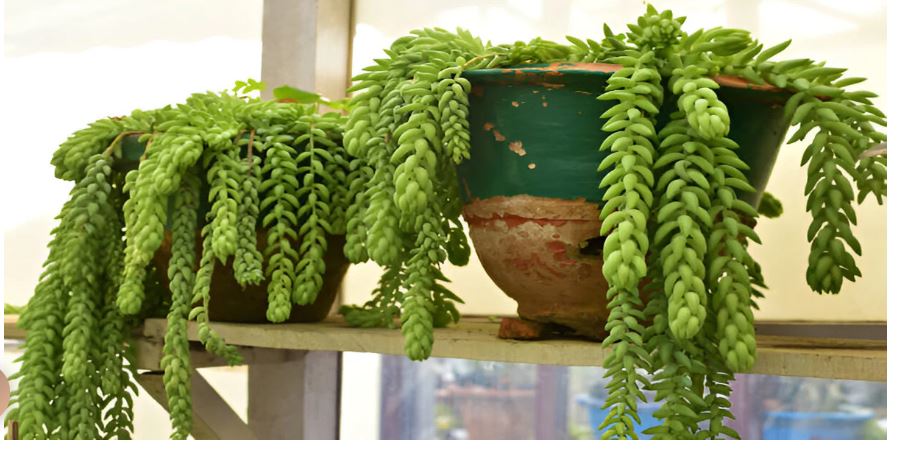
Sedum morganianum, the donkey tail or burro’s tail, is a species of flowering plant in the family Crassulaceae, native to southern Mexico. It is a succulent perennial producing trailing stems up to 60 cm long, with fleshy blue-green leaves and terminal pink to red flowers in summer. This plant has been found wild in two ravines at Tenampa county, in central Veracruz, in eastern Mexico and on vertical cliffs of igneous rock in the Tropical Deciduous Forest zone.
Characteristics of Burro’s Tail (Sedum morganianum)
- Appearance: Burro’s Tail, also known as Donkey’s Tail, is a succulent with trailing stems that can grow up to 3 feet long or more. The stems are covered with small, fleshy, blue-green leaves which are densely packed and overlap each other, giving the plant its distinctive, tail-like appearance.
- Leaves: The leaves are bean-shaped, about 1/2 inch long, and have a slight powdery bloom, which helps reduce moisture loss. When the plant is stressed, these leaves can turn from green to a reddish hue.
- Flowers: It produces small, pink to red flowers at the tips of the stems, but flowering is not common in indoor settings. The blooms can appear when the plant receives enough light and is mature.
- Growth Habit: This plant grows vertically at first but soon starts to trail, making it an excellent choice for hanging baskets or high shelves where its foliage can cascade down.
Cultivation of Burro’s Tail
- Light: Prefers bright, indirect sunlight. This plant exhibits a clearly visible wax layer (farina) on its leaves and stems, an indication of its preference for (bright) shade and sheltering from hot sun
- Water: Like most succulents, Burro’s Tail needs very little water. Allow the soil to dry out completely between waterings. Overwatering can lead to root rot, which is a common issue with this plant. In winter, reduce watering significantly as the plant goes dormant.
- Soil: Use a well-draining cactus or succulent mix. You can also mix in some coarse sand or perlite to improve drainage. This plant dislikes being in overly moist soil.
- Temperature: It thrives in average room temperatures, between 65-75°F (18-24°C). Protect from frosts, as it’s not cold hardy.
- Humidity: It’s quite tolerant of dry indoor conditions, typical of most succulents.
- Fertilizer: Feed sparingly. A balanced, water-soluble fertilizer diluted to half strength can be applied once during the growing season (spring or summer).
- Propagation: Easily propagated from leaves or stem cuttings. Leaves or sections of the stem that fall or are cut will root if placed on soil. Let the cuttings dry out for a couple of days to form a callus before planting. Leaf propagation can be a bit slower but is very straightforward.
- Pests: Generally pest-resistant, but occasionally can be affected by mealybugs or aphids. Treat with insecticidal soap or neem oil if needed.
- Repotting: Repotting isn’t often necessary due to its slow growth, but when you do, use a pot with drainage holes to avoid waterlogging the soil.
- Handling: Handle with care; the leaves are quite fragile and can easily detach with the slightest disturbance, although this also makes propagation easy.